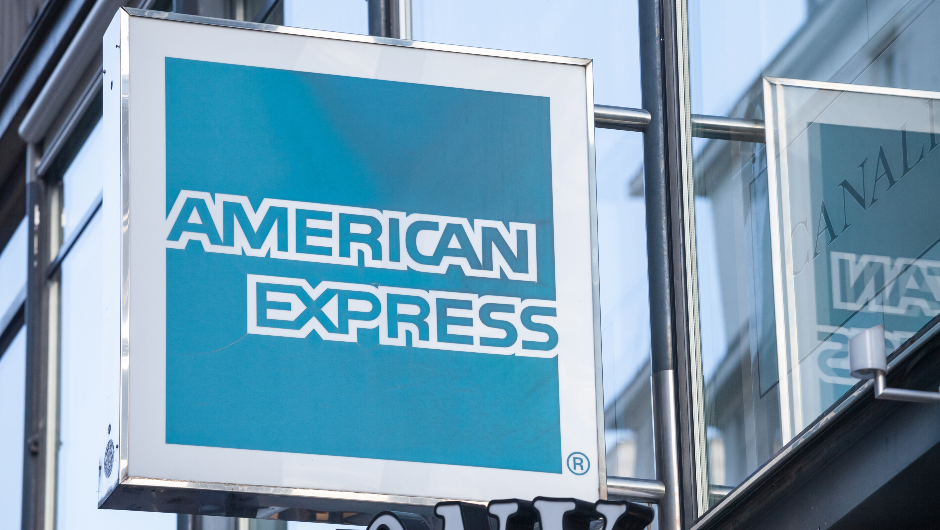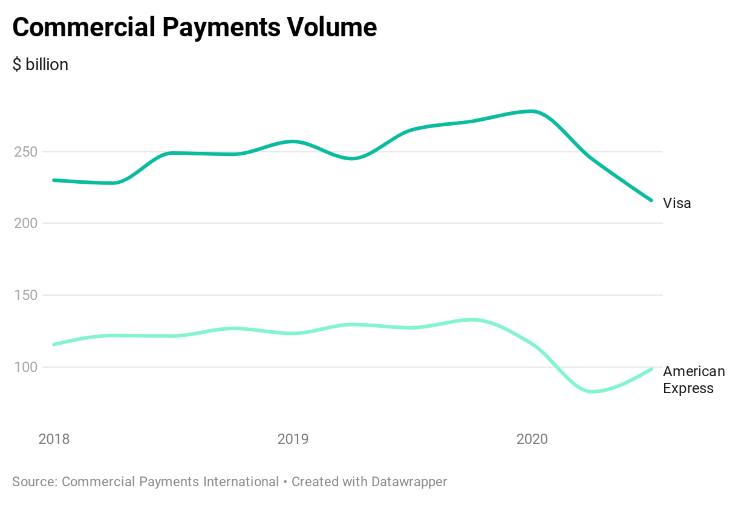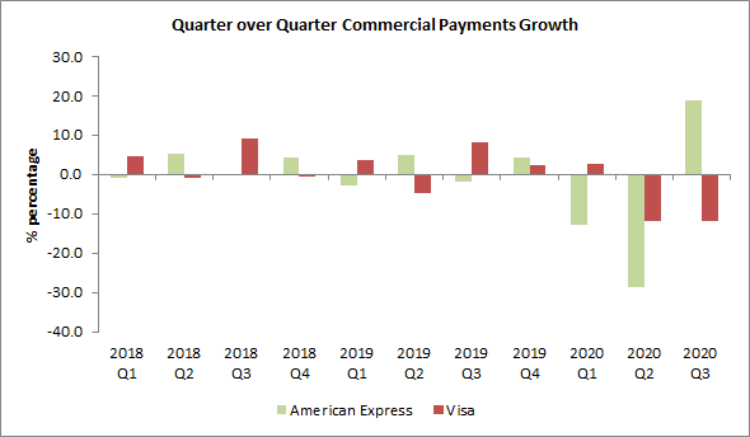Commercial payments struggled to pick up pace in Q3

Card giants American Express and Visa showed a decline of 22% and 19% YoY in their commercial payments business respectively. T&E segment recovery continues to be dubious.
Facing extreme headwinds this year due to Covid-19, card giants have reported yet another quarter of decline in their commercial payments business. Last month, Visa and Mastercard released their 8K SEC filings in which they highlighted the improvement of payment transactions but were held back by a mammoth drop in travel and expense business.
In its latest SEC filings, American Express recorded $98.5 billion in proprietary billed business in Q3 2020, representing a rise of 19% from the previous quarter but a 23% decline in year-over-year terms. Similarly, its arch-rival, Visa Inc. reported its commercial payments business at $216 billion, a decline of 12% from the previous quarter and 18% decline YoY.

American Express commercial payments business in Q3 is the lowest since Q1 2015 while for Visa, it’s the lowest since Q3 2017.
Commenting on the recovery in B2B payments, Chief Financial Officer at Visa, Vasant Prabhu noted in an earnings call that, “in the card-based part of the business, we are seeing the small business side recover nicely. The large and medium-size side is the one that is still somewhat sluggish”.
In terms of year-over-year, the past three quarters for both American Express and Visa have experienced a decline in commercial payments.

Mastercard reported a small decline by 0.24% YoY in Gross Dollar Volume at $1648 billion in Q3 but a rise of 19% from Q2 2020. GDV comprises of commercial as well as consumer spending. Mastercard did not disclose its commercial payments volume in its 10Q SEC filings.
American Express’s per card spending was up by 20% from the previous quarter by declined by 21% YoY. It stood at $6,776 spending per card, the lowest in the past 4 years.
Travel and Expense recovery remains uncertain
Due to partial lockdowns and strict border control, travel and expense (T&E) business continues to be in bad shape. Mastercard reported a decline in cross-border volume fees by 48% YoY at $791 million in Q3 2020 but in terms of Q/Q, it was up by 22%.
Visa’s CFO, Vasant Prabhu notes that “the cross-border recovery has been sluggish since borders remain closed or there are significant impediments to crossing borders like quarantines and other such restrictions”. Visa reported a 29% decline YoY in cross-border volume in Q3 2020.
Commenting further, Prabhu noted, “the cross-border business comes with higher yields. This significant shift in mix is a drag on revenue growth, which will continue into fiscal-year 2021 until the cross-border business recovers”.
American Express was no exception to this. It reported a decline of 69% YoY in T&E expense in the third quarter.
AmEx’s CEO, Steve Squeri in the Q3 earnings call highlighted, “the T&E component of our corporate card business is really, really down. And the reality is that component, though, of our business is only 6% of our overall business”.
Road to recovery
Despite sluggish growth in the third quarter of this year, the card giants have positioned themselves to exploit innovations in commercial payments.
American Express in its earnings call noted that the company is placing a greater emphasis on the investment process. The company identified critical areas of investment as ‘accelerating customer acquisition activities’, ‘developing additional solutions beyond the card to expand relationships with small businesses’, ‘maintaining virtual parity coverage in the U.S. and expanding merchant coverage in key international markets and enhancing our digital capabilities across the business.’
To revive its T&E segment, AmEx announced its payment integration with SAP Concur in Q3. In Europe, the company teamed up with Yapily to expand its Pay with Bank Transfer programme. Before that, AmEx had announced its joint venture with Express (Hangzhou) Technology Services Company Limited which gave the company network clearing licence in China.
“And within our commercial business, AP automation volumes continued their rapid growth, although from a small base, doubling since last year’s third quarter as more businesses adopt digital payment solutions’, said Steve Squeri, Chief Executive Officer at American Express. The company in Q3 had launched its accounts payable solution ‘American Express One AP’ for the US businesses.
The adoption of digital payments methods across the business was also echoed by Visa’s CEO Al Kelly in Q3 investors call and stated, they were addressing this increased demand by ‘engaging with a broad range of issuers and partners’, ‘expanding into new verticals’ and ‘investing to streamline operations and enable acceptance’.
The company partnered with Nium to expand its card issuance service in Europe. Under its Fintech Fast Track Program, it teamed up with Accualify to launch corporate cards. Last month, it collaborated with Boost Payments Solutions to streamline its commercial card use.
Meanwhile, Mastercard’s President, Michael Miebach in investors call commented that “at the infrastructure level, we continue to make good progress with our build-outs and have a strong position in all major geographic regions including key markets like the U.S., the U.K., Nordics and Saudi Arabia”. The company is also ‘building off strong position in infrastructure, by making progress in the application layer, utilizing our multi-rail capabilities’.
A slew of fintech partnerships with Mastercard were announced in the third quarter including EedenBull, Emburse, Tide, Treezor and TransferWise. In China, it partnered with Bank of Shanghai which authorised cross-border B2B payments.